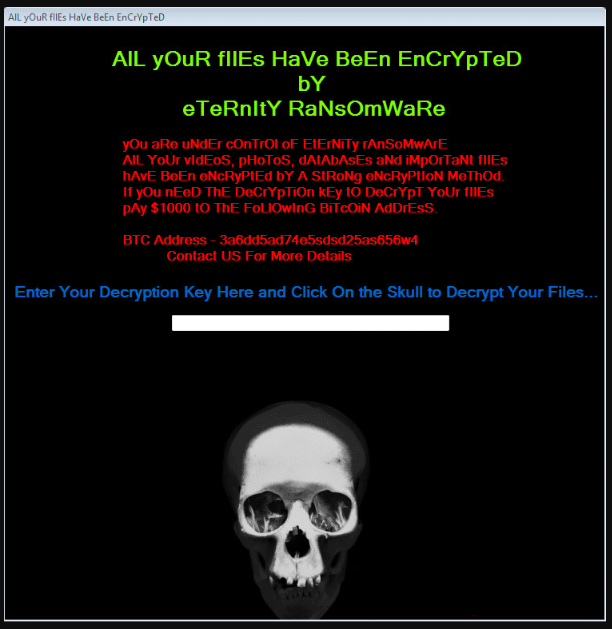What is Eternity ransomware?
Eternity ransomware is a file-encrypting malware that is currently for sale. Malware researchers from threat intelligence company Cyble were the first ones to discover this malware, along with other malware like the Eternity Stealer, Eternity Miner, Eternity Clipper, Eternity Worm + Dropper, and Eternity DDoS Bot. Eternity ransomware is being sold for $490. It appears to be a pretty standard ransomware infection that will target personal files and demand a payment in exchange for a decryptor.
Threat actors who purchase the Eternity ransomware can make certain customizations, including a custom ransom note, as well as a time limit for when file decryption becomes no longer possible. Because Eternity ransomware is offered as Malware-as-a-Service (MaaS), the contents of the ransom note, decryptor price, time limit, etc., will differ depending on who operates it. But it does not appear that the ransomware changes file names once it’s done encrypting them.
The ransomware, as usual, targets personal files. That means photos, videos, images, documents, etc., would all be encrypted. File names should not change so it may be difficult to tell which files have been encrypted. Once it’s done encrypting files, the ransomware will drop a ransom note that explains how users can acquire a decryptor. The sum demanded by the cybercriminals will depend on the operators but it’s likely to be around $1000. Generally, paying the ransom is a bad idea. While it may be the only option for some users, it’s worth mentioning that there are no guarantees a decryptor will be sent to them. Victims should keep in mind that it is cybercriminals they are dealing with, and trusting them to keep their end of the deal is never recommended.
If users have backup and a good recovery plan, paying the ransom shouldn’t even be a question. However, it’s important to first remove Eternity ransomware using anti-malware software before connecting to the backup. If the ransomware is still present on the computer when the backup is accessed, the backed-up files may become encrypted as well.
How is ransomware distributed?
Because Eternity ransomware is MaaS, the distribution methods may differ depending on who is operating it. However, the usual methods will likely apply no matter who controls Eternity ransomware. Among the most common methods are email attachments, torrents, malicious downloads, online scams, fake updates, etc. Generally, users with good browsing habits are less likely to infect their computers with malware, including ransomware.
It’s common knowledge that one of the reasons why users are discouraged from pirating copyrighted content using torrents is that torrents are often full of malware. Many torrent sites are quite poorly moderated, which means malicious actors can easily upload torrents that contain malware. Torrents for popular movies, TV series, software, video games, etc., are particularly like to have malware in them. Users should keep in mind that using torrents to pirate is not only stealing content but also endangering the computer/data.
Ransomware is also often encountered in email attachments. The emails are often made to appear like they’re official correspondence from companies whose services users use and talk about money in order to pressure users into opening the email attachments. If users do open a malicious attachment, the malware can initiate. But in many cases, the emails are fairly obvious. The biggest giveaway is grammar/spelling mistakes. Strangely enough, malicious emails are often full of mistakes, though that works in users’ favor. Such emails also use generic greetings when addressing users (User, Member, Customer, etc.) when users’ names should be used. Since cybercriminals don’t always have access to personal information, they are forced to use generic greetings. But in some cases, the malicious emails may be much more sophisticated. It’s highly recommended that users scan all unsolicited email attachments with anti-virus software or VirusTotal before opening them.
Eternity ransomware removal
Considering that ransomware is a highly complex malware infection, it’s best to use a reliable anti-malware software to remove Eternity ransomware from the computer. Manual Eternity ransomware removal could lead to additional issues unless users know exactly what to do. Those with backup can access it to start recovering files as soon as they delete Eternity ransomware from their computers.
Offers
Download Removal Toolto scan for Eternity ransomwareUse our recommended removal tool to scan for Eternity ransomware. Trial version of provides detection of computer threats like Eternity ransomware and assists in its removal for FREE. You can delete detected registry entries, files and processes yourself or purchase a full version.
More information about SpyWarrior and Uninstall Instructions. Please review SpyWarrior EULA and Privacy Policy. SpyWarrior scanner is free. If it detects a malware, purchase its full version to remove it.

WiperSoft Review Details WiperSoft (www.wipersoft.com) is a security tool that provides real-time security from potential threats. Nowadays, many users tend to download free software from the Intern ...
Download|more


Is MacKeeper a virus? MacKeeper is not a virus, nor is it a scam. While there are various opinions about the program on the Internet, a lot of the people who so notoriously hate the program have neve ...
Download|more


While the creators of MalwareBytes anti-malware have not been in this business for long time, they make up for it with their enthusiastic approach. Statistic from such websites like CNET shows that th ...
Download|more
Quick Menu
Step 1. Delete Eternity ransomware using Safe Mode with Networking.
Remove Eternity ransomware from Windows 7/Windows Vista/Windows XP
- Click on Start and select Shutdown.
- Choose Restart and click OK.

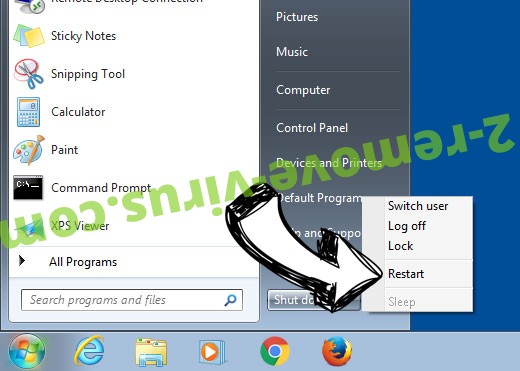
- Start tapping F8 when your PC starts loading.
- Under Advanced Boot Options, choose Safe Mode with Networking.

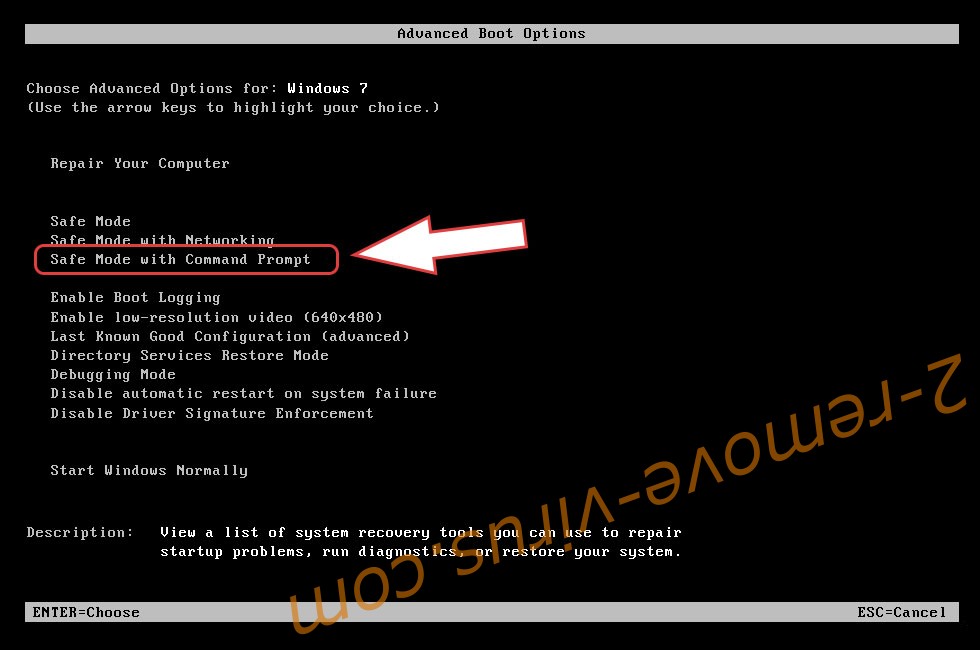
- Open your browser and download the anti-malware utility.
- Use the utility to remove Eternity ransomware
Remove Eternity ransomware from Windows 8/Windows 10
- On the Windows login screen, press the Power button.
- Tap and hold Shift and select Restart.

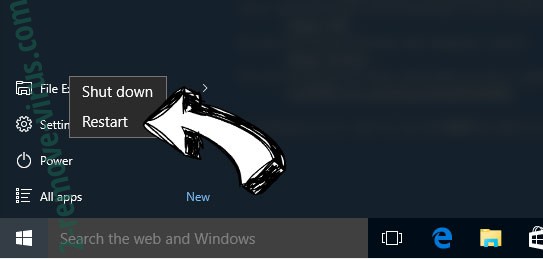
- Go to Troubleshoot → Advanced options → Start Settings.
- Choose Enable Safe Mode or Safe Mode with Networking under Startup Settings.

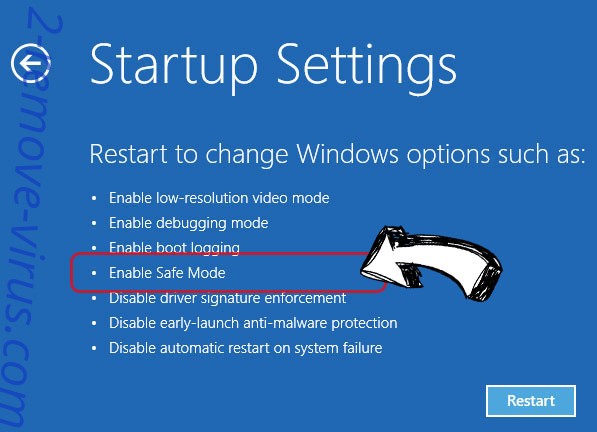
- Click Restart.
- Open your web browser and download the malware remover.
- Use the software to delete Eternity ransomware
Step 2. Restore Your Files using System Restore
Delete Eternity ransomware from Windows 7/Windows Vista/Windows XP
- Click Start and choose Shutdown.
- Select Restart and OK


- When your PC starts loading, press F8 repeatedly to open Advanced Boot Options
- Choose Command Prompt from the list.

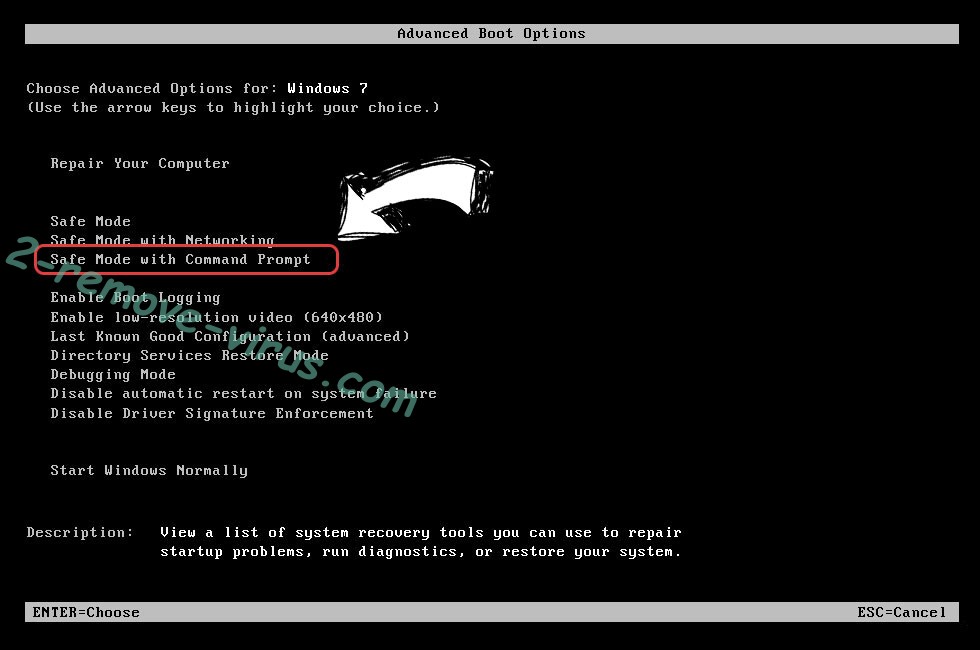
- Type in cd restore and tap Enter.

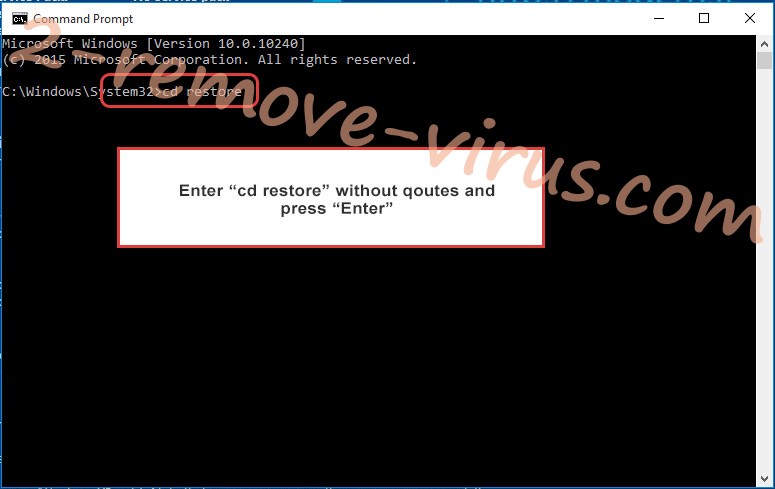
- Type in rstrui.exe and press Enter.

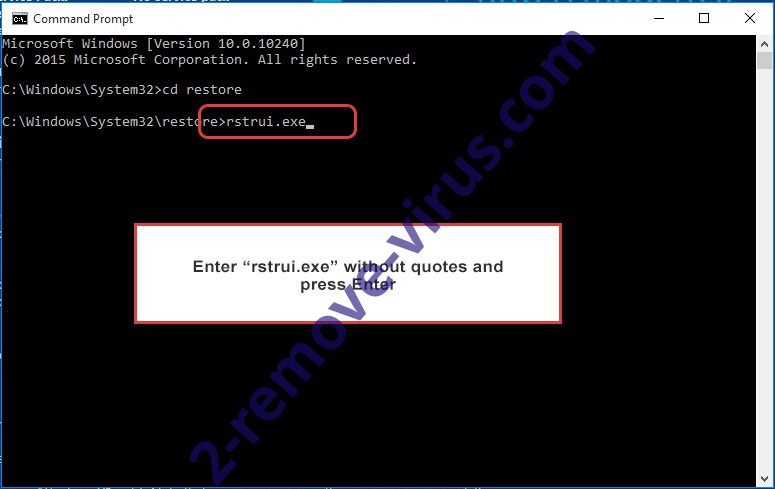
- Click Next in the new window and select the restore point prior to the infection.

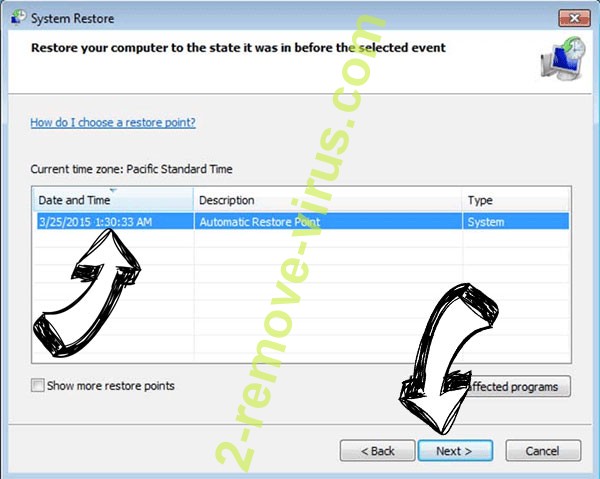
- Click Next again and click Yes to begin the system restore.

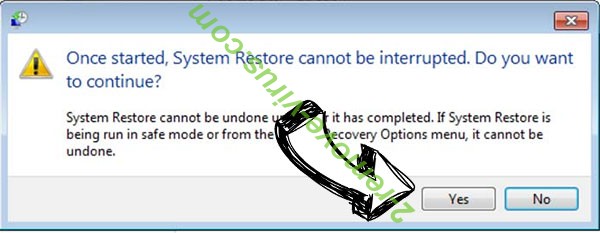
Delete Eternity ransomware from Windows 8/Windows 10
- Click the Power button on the Windows login screen.
- Press and hold Shift and click Restart.


- Choose Troubleshoot and go to Advanced options.
- Select Command Prompt and click Restart.

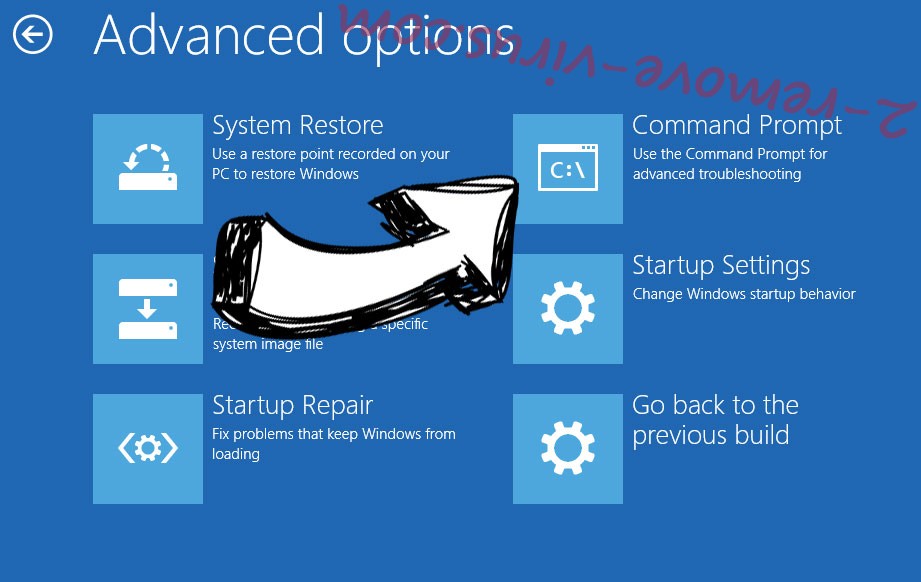
- In Command Prompt, input cd restore and tap Enter.


- Type in rstrui.exe and tap Enter again.


- Click Next in the new System Restore window.

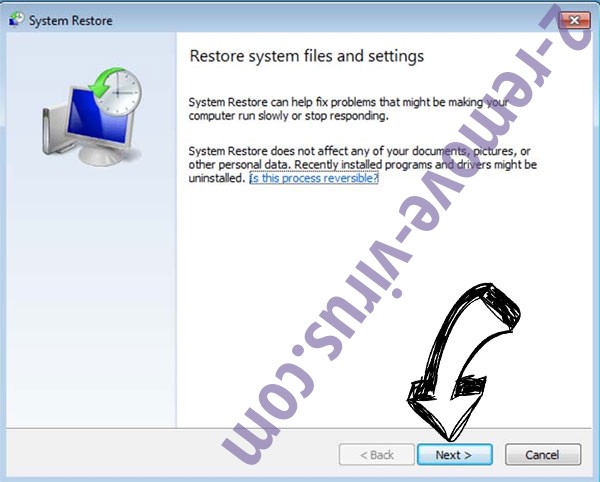
- Choose the restore point prior to the infection.


- Click Next and then click Yes to restore your system.


Site Disclaimer
2-remove-virus.com is not sponsored, owned, affiliated, or linked to malware developers or distributors that are referenced in this article. The article does not promote or endorse any type of malware. We aim at providing useful information that will help computer users to detect and eliminate the unwanted malicious programs from their computers. This can be done manually by following the instructions presented in the article or automatically by implementing the suggested anti-malware tools.
The article is only meant to be used for educational purposes. If you follow the instructions given in the article, you agree to be contracted by the disclaimer. We do not guarantee that the artcile will present you with a solution that removes the malign threats completely. Malware changes constantly, which is why, in some cases, it may be difficult to clean the computer fully by using only the manual removal instructions.
